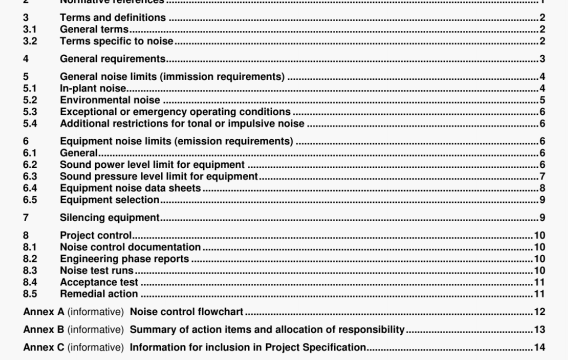ISO 15664 pdf download – Acoustics – Noise control design procedures for open plant.
Noise limits can be given (or each of me above aspects of noise control, relative to certain areas inside or outside the plant. For the purposes of this International Standard, they are referred to as “general noise limits. They are specified in clause 5.
Noise limits for each iten of equipment shall be derived from the general noise limits, as applicable for the equin’ient in its specific position in the plant. These are commonly referred to as “equipment noise limits”. Procedures for deriving equipment noise lwTiil$ are specified in clause 6.
Each potential noise source shall be subect to the requirements of this International Standard.
Authorities may enforce obligations to reduce noise levels as far as reasonably practicable. Recommendations for
noise limits may be found In national or International Standards. e.g. ISO 11690-1 (work place). ISO 9921-1
(speech communication) and ISO 1996 series (environment)
The specified limits shall be met for the design operating conditions of the plant. They shall also hold for other operating Conditions wtiicfl occur occasionay, such as stan-up. Shutdown, regeneration and maintenance, unless specified otherwise by the end-user and agreed with the contractor. The only requirement for emergency situations (i.e. any conditions other than just cfescribecil which can be foreseen or predicted (e.g. relief valve operation) is that the absolute limit specified i5.1.2 shall not be exceeded.
The end-user may set specific noise limits applicable to the construction phase of the project. These hmits may be set to meet environmental requirements.
This International Standard deals with noise from more or less stationary equipment. However, noise radiated from mobile noise sources, such as transportation vehicles (lorries, trucks, railway equipment) or mobile maintenance equment, in the plant or workshops might have to be taken into consideration. Noise due to mobile sources is more important If relatively high numbers of vehicles are present near the boundaries of the plant, also because noise reduction is often hard to achieve for this type of source, Therefore parties shall investi9ate whether or not this kind of transportation noise has to be considered as part of the noise control procedures.
The planning br and extent of the noise control engineering for a plant is based heavily on the project specification. It is always vifal that all of the noise limits and any other noise requirements specified by the end-user be carefully and completely defined in the profect specification. This is particularly true where more than one contractor is involved or where the plant (or part thereof) might be operated by other than the end-user or contractor. In addition to the noise limits, the project specification should include all applicable items from annex C.
This International Standard defines a number of specific tasks that may be performed during a protect. These tasks are assigned an action item (Al, A2, A3. etc.). The responsibility for the execution of these action items is assigned to either the end-user or the contractor as stated in annex B, where a summary of the action items is included.
5.1.4 Restricted area
Restricted areas are those work areas in the panl where, according to the state ci the art, it is not reasonably practicable to reduce the noise level at or below the work area limit. The absolute limit remains valid in such areas.
lilt is unavoidable that the work area limit will be exceeded around particular equipment, action shouki be taken to limit the area involved as far as Is economically and technicaMy feasible. This may include the erecbon of an acoustic enclosure Areas inside acoustic enclosures around suci, equipment may be restricted areas.
(A3) The contractor shall identify the potential restricted areas to the end-user. Written permission shall be obtained Iron, the end-user to designate an area as a restricted area. The end-user and contractor shall discuss and agree the noise levels that may be permitted in these noise restricted areas, taking Into account authority requirements
(A4) Permanent warning signs to indicate the mandatory use of ear protectors shall be erected at the boundaries of restricted areas. The signs shall be ci the type specibed in ISO 3864.
ISO 15664 pdf download – Acoustics – Noise control design procedures for open plant
